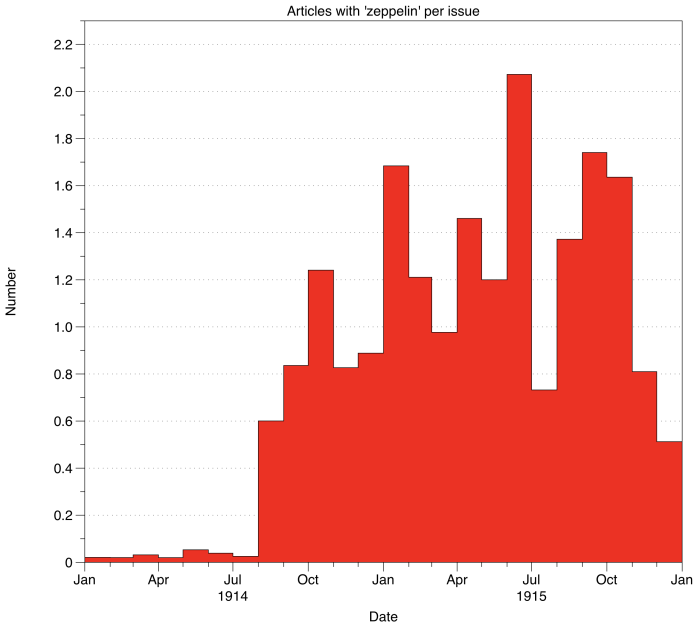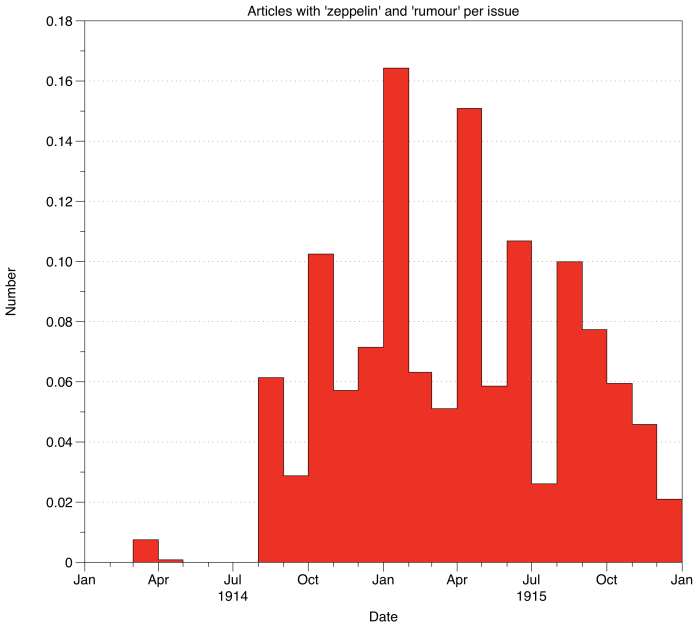In order to start characterising the possible airship panic of 1915, let’s generate some n-grams and do some distant reading to get a basic overview of press interest in Zeppelins during the early part of the war. Here are the number of articles per month in the British Newspaper Archive for 1914 and 1915 mentioning the word ‘zeppelin’, normalised by the number of issues published each month, to account for variations in BNA’s coverage (since, if there are more newspapers in total, all else being equal you would expect to get more articles about Zeppelins).1
There are a few things that are apparent from this plot. One is that the start of the war is really obvious: Zeppelins are mentioned ten or more times more frequently from August 1914 onwards than in the earlier part of 1914. (Even the peak of the 1913 airship panic was only about a fifth of the level of August 1914.) In the wartime period itself, there are a number of peaks. The biggest is in June 1915, which corresponds to the aftermath of the first Zeppelin raid on London. The next biggest are January 1915, the period of interest here, and September-October 1915, in which there were a dozen raids in total. Also of interest is October 1914, when there were no air raids on Britain at all. This was when the possibility of aerial attack began to be taken seriously (and when the Zeppelin panic of 1914 took place, but that’s a subject for another day, or article).
This does show that there was a lot of press interest in Zeppelins in January 1915. But then, given that the first Zeppelin raid on Britain took place in that month, most or all of that peak is going to be relatively straightforward reporting rather than scaremongering. (Which is not to say it can’t be both.) So let’s try something I’ve done before and search for articles which mention both ‘zeppelin’ and ‘rumour’, on the basis that these might contain the kind of dubious stories that reflect or create panic.
The same peaks are still visible, but they have changed in a couple of ways. One is that the peaks stand out more relative to the surrounding months. So ‘rumour’ is more commonly found in association with ‘zeppelin’ when the latter is more often in the news for whatever reason. But it’s not just that, because the other change is that the peaks have changed in height relative to each other. In fact, it’s now the January 1915 peak which is the strongest of all. (Interestingly, not far behind is April 1915 when there were four Zeppelin raids, even though it’s only just visible in the first plot.) Also, the peaks get lower as 1915 goes on.
Let’s try a more fine-grained distant reading to try to work out when exactly the panic might have taken place, by switching from a monthly view to a daily one. Here is the frequency of ‘zeppelin’ each day from 1 November 1914 through 28 February 1915:
There are four substantial peaks here.2 The biggest occurs after the Norfolk raid of 19 January 1915. The one in late November 1914 is presumably the result of the Friedrichshafen raid (i.e. by the British on the Germans, not the other way around). A similarly-sized peak at the other end of the plot, in late February 1915, related to coverage of two separate Zeppelin crashes off Denmark. And then there’s a very noticeable one in the last few days of December 1914, which appears to correspond to a Zeppelin attack on Nancy.
Finally, here’s the above plot but for ‘zeppelin’ and ‘rumour’:
Now, while the data is starting to get patchy in an absolute sense, there are still some striking relative changes. The peaks relating to ‘good’ Zeppelin news (the Friedrichshafen raid and the Zeppelin accidents) have disappeared, suggesting that they aren’t associated with rumours; whereas those relating to ‘bad’ Zeppelin news (the raids on Nancy and Norfolk) are still visible and so do seem to be accompanied in the press by rumours. Moreover, by inspection (i.e. I can’t be bothered trying to quantify it in any way) it’s clear that there’s a significant, if inconsistent, increase in articles mentioning both ‘zeppelin’ and ‘rumour’ from the last few days of December 1914 through to the middle of January 1915, and after a gap of a few days a similar but steadier increase from the time of the Norfolk raid through to early February 1915. This is at least consistent with the idea of a Zeppelin panic throughout January 1915 (and a few days either side).
Obviously, distant reading of this kind is hardly a foolproof method; there could be reasons for such an association between the words ‘zeppelin’ and ‘rumour’ which have nothing to do with any kind of panic, for example. So while all this might all be suggestive of a panic over the possibility of Zeppelin raids in January 1915. But a closer, more traditional reading will be needed to determine that.
![]() This work is licensed under a Creative Commons Attribution-NonCommercial-NoDerivatives 4.0 International License.
Permissions beyond the scope of this license may be available at http://airminded.org/copyright/.
This work is licensed under a Creative Commons Attribution-NonCommercial-NoDerivatives 4.0 International License.
Permissions beyond the scope of this license may be available at http://airminded.org/copyright/.
- It would be much better to use the total number of articles each month for this normalisation, but I don’t know how to get that from BNA. Words common enough to appear in practically all articles, like ‘the’, are now stop words, so they can’t be used to estimate how many articles there are in total. [↩]
- The very narrow spikes are mostly artefacts of the normalisation process: BNA has only one Sunday paper for 1914 so if that paper happened to have a few articles about Zeppelins it will lead to an exaggerated signal. [↩]






Pingback: The airship panic of 1915 — III – Airminded